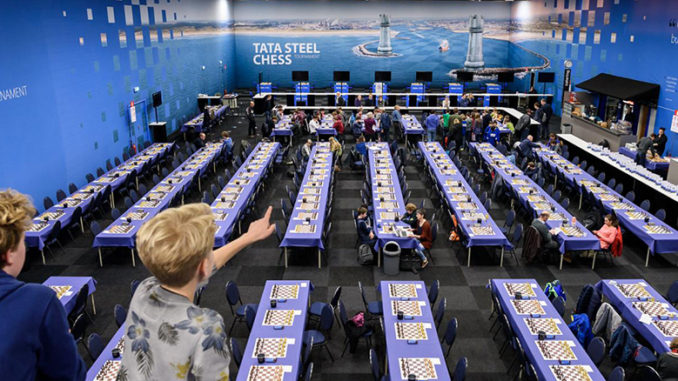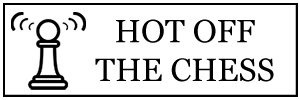
The Tata Steel Chess Tournament 2018, went on the road to Groningen for round 10 on Wednesday 24th January. It would be the last round before the final rest day. And this rest day would probably be needed as Groningen is a couple of hours away from the tournament’s regular home of Wijk aan Zee.
The standings saw Anish Giri in sole lead of the Masters group, with 6.5/9 and after a tour of the Groningen Museum of Art and Art History, play resumed in the academy building of Groningen University. The round saw the following results:
Hou, Yifan ½-½ Adhiban, Baskaran
Wei, Yi ½-½ Caruana, Fabiano
Giri, Anish ½-½ Karjakin, Sergey
Kramnik, Vladimir 1-0 Matlakov, Maxim
Svidler, Peter 0-1 Mamedyarov, Shakhriyar
Carlsen, Magnus 1-0 So, Wesley
Jones, Gawain 0-1 Anand, Viswanathan
Mamedyarov Floors Svidler to Join Lead
Peter Svidler did not have a pleasant time of things in Groningen. Unfortunately, the Russian Champion would have another painful game. If you remember, Peter had lost to Anish Giri in 21-moves in round three and he would do the same in this round against Shakhriyar Mamedyarov. What is extremely concerning, here, apart from the losses themselves, is that both of them came with White.
This game was a Ragozin Queen’s Gambit Declined and Peter was quite simply out prepared. Actually, this perhaps does not quite go far enough, more correct is to say that Peter was extremely badly prepared. His 9.g3 (see diagram, below) appears to be a novelty but Shakhriyar seems to have been the more ready for it.
Black’s 9…g5 came almost instantly and this was followed by 10.Be3 f5 which already saw Black taking the fight to White strongly. It is true that Black has opened his King by thrusting his pawns in this way, but any risk was minimal and as it turned out, irrelevant. After 10.Be3 f5 11.Bg2 f4 12.gxf4 Bxc3+ 13.bxc3 gxf4 14.Bd2 Kh8 (diagram, below), White had to find the right way to go and to this end Peter slumped into a deep think of over 30-minutes.
Deep thinks are not always a sign of bad things in chess, (though one should try and avoid them if at all possible), but in this case, it was. White was already having issues, namely terrible pieces. Black was threatening to become active very quickly on the Kingside with moves like …Bg4, …Rg8 and perhaps after the removal of the Nf3, …Qh4.
White’s problem was twofold, how to stop Black’s very simple plans and how to compete with them. While the Black pieces were threatening to descend upon the White King, his own was looking untouchable. And this appears to have sent Peter to the chess loony-bin. His 15.Qb3(?) just was not good enough to cause Black any difficulties. In itself it is a well founded move, anticipating …Bg4, when Qxb7 would be a nice answer, claiming a pawn and threatening Qxc6.
Unfortunately, though, it was an example of chess blindness. This can occur after a long think, when one risks ending up not being able to see the wood for the trees. It is hard to suggest alternatives for Svidler, his position is already under severe pressure, but perhaps 15.h3 is rather forced. It is a horrid move to play, here, but it does at least prevent …Bg4 — and more importantly, offers Black no target.
After 15.Qb3, there came 15…Na5 and again this was quite quickly played. And from here, Svidler capitulates rapidly, 16.Qc2 sees him severely on the back foot and after Mamedyarov’s strong 16…Nc4(!) to say that White is passive is an understatement. Already facing time considerations, Svidler decided to respond to the very clear threat of …Bg4 and …Bxf3, (which leaves the Bd2 inadequately defended), with 17.Rd1. Then came the inevitable 17…Rg8 (diagram).
This position is already utterly losing, there is just too much going on and it is hard for White to deal with the threat to his Bg2. 18.Rg1, for example, would be completely embarrassed by 18…Bh3(!!) when 19.Bxh3 would leave 19…Rxg1+ followed by …Qh4. And to 18.Bf1, there is 18…Nexd2 when Rxd2 is the only respectable recapture as Nxd2 would present …Ne3! White is completely swimming with sharks.
Peter went for 18.Nxe5 in the end, but Black’s continuation here was very straight forward: 18…Nxe5 19.Bxe4 Qg5 with the threat of …Qg1+ followed by …Rg1 mate. 20.Bxf4 Qxf4 21.Bxd5 Bf5(!) and here, having technically escaped the miniature, Peter Svidler called it a day. Should he save his Queen, his King will face an onslaught.
I have to admit that I am worried about how this game will affect Peter and this is very sad because he is one of the nicest people I have met during my times at Wijk aan Zee over the years. He was already very dissatisfied with his play in this tournament and this result will only add to any concerns. Obviously there is something wrong at the moment and I really hope that Peter can sort it out and end the tournament on a higher note.
As for Shakhriyar Mamedyarov, this was a great game from the world number two (if one can call it a game based on how little he actually played of it — he used only 30-minutes or so) and it put him back to sharing the lead. In the next round he will play fellow leader, Magnus Carlsen with White — an exciting prospect!
Carlsen Pulls Out The Stops vs So
As for Magnus Carlsen, he used the London System in order to take a point from Wesley So. One of the most exciting things to watch when it comes to the World Champion, is when he breaks from the leashes of theoretical lines and just plays. And this game was a fine example.
The game followed one that Wesley had himself played, but as White, against Radoslaw Wojtaszek at the 2017 Gashimov Memorial. That game had been a draw, but Carlsen had other intentions for this one, varying from So’s 10.c5 with 10.cxd5. It has to be said that Wesley coped very well with this until his 18…Nd4+. It wasn’t that the move was bad, but after 19.Nxd4 Qxd4 20.f4, Magnus had a very comfortable position, (shown in the diagram. below), in which he could proceed in the game without risk.
This is the kind of position that Magnus Carlsen excels at. It has to be said that any advantage is negligible, but he has shown on numerous occasion that he can generate play from nowhere. This all boils down to his vision and creativeness, in which he is largely unmatched at the board.
And once again this proved to be the case. Carlsen made subtle moves in order to get his pieces to good squares and then gave up a pawn in return for active piece play. When he regained the pawn, it was with a superior stance in the endgame that allowed him to push. Later he made the bold decision to sacrifice the exchange of his bishop in return for two pawns (see diagram).
This was inspired and it seems that with correct play by his opponent, White maintains the best of play. 43…Rg6+ 44.Kf3 Bc5 45.b4 Re3+ 46.Kg2 Re2+ 47.Kh3 Re7 48.Rxe7 Rh6+ 49.Kg2 Bxe7 50.Rc8+ Kf7 51.Ra8, for example, sees White with play on both sides of the board and the engine evaluations that give a +40-ish edge are rather conservative in my opinion.
As it was, So went for 43…a5 and after this, White’s pawns proved themselves more potent than the bishop and though it took another thirty-plus patient and controlled moves, Carlsen made conversion look effortless. A very nice game to give him a share of the lead.
Matlakov Lapses Against Kramnik; Anand Adds to Jones’ Pain
The other two winners of the round were veterans Vladimir Kramnik and Viswanathan Anand. In Kramnik’s case, he would not have an easy game against Maxim Matlakov, who managed to equalise nicely in the Giuoco Piano and obtain good play. And when Kramnik sacrificed the exchange of rook for knight, it looked like his opponent might even be turning things around.
In the diagram position, had Black found 32…Rb6, the game may have become very interesting, but after 32…Rc5(?) 33.Qd4 Nb6, White was running free with 34.Rxb7. This was until Kramnik’s slightly too safe 36.Qc3(? 36.Rf7!) which gave Matlakov the chance of survival with 36…Nd7(!) However, this was not taken advantage of and after 36…Rc8, things went rapidly downhill for the debut maker and he resigned utterly lost on move 39.
Gawain Jones had experienced the bitterness of having two games in a row that he really should have won, but didn’t. The first, against Magnus Carlsen, he ended up losing and the second, against Hou Yifan, he would draw. Unfortunately, this game would see anything but a change in fortunes as the Englishman was hardly present as White against Vishy Anand.
In the Alapin Sicilian, Anand equalised effortlessly and soon held the advantage. Jones’ position became very passive and such was Anand’s domination in the position that White claiming a rook for bishop hardly dented it. Sadly for Gawain, it was quite the rout in the end. As can be seen in the diagram, below, he resigned facing a strong trio of Black pawns, one of which was destined to become a new Queen.
Then There Were Three Again
The other games were drawn, including Anish Giri against Sergey Karjakin. They were not up for it in this round and just exchanged down steadily before shaking hands on move 26. This meant that Giri’s time having the lead to himself was over. He would again be joined by Carlsen and Mamedyarov on 7.0/10.
Masters Standings after 10 Rounds:
Giri, Carlsen, Mamedyarov — 7.0
Kramnik — 6.5
Anand — 6.0
So, Karjakin — 5.5
Svidler — 4.5
Wei, Jones, Matlakov, Caruana — 4.0
Adhiban — 3.0
Hou — 2.0
Masters Round 11 – Friday 26th January
The players now have a rest day on Thursday before the final three rounds over the weekend. When play resumes on Friday, it will see Shakhriyar Mamedyarov taking on Magnus Carlsen with White. Elsewhere, Anish Giri faces Fabiano Caruana with Black. Each pairing is actually quite interesting for one reason or another, so let’s hope that the players come out with their sleeves rolled up!
Anand, Viswanathan – Hou, Yifan
So, Wesley – Jones, Gawain
Mamedyarov, Shakhriyar – Carlsen, Magnus
Matlakov, Maxim – Svidler, Peter
Karjakin, Sergey – Kramnik, Vladimir
Caruana, Fabiano – Giri, Anish
Adhiban, Baskaran – Wei, Yi
No Change At Top in Challengers
In the Challengers group, Anton Korobov and Gujrathi Vidit are still leading. Both would draw their games, the most effort being made by Vidit as Black against Jeffrey Xiong. Korobov did not make the most of his White game against Erwin L’Ami, which lasted all of 22-moves.
The winners of the round were Dmitry Gordievsky with Black against Benjamin Bok and Matthias Bluebaum against Lucas van Foreest.
Bok, Benjamin 0-1 Gordievsky, Dmitry
Bluebaum, Matthias 1-0 Van Foreest, Lucas
Xiong, Jeffery ½-½ Vidit, Santosh Gujrathi
Korobov, Anton ½-½ L’Ami, Erwin
Girya, Olga ½-½ Harika, Dronavalli
Van Foreest, Jorden ½-½ Amin, Bassem
Tari, Aryan ½-½ Krasenkow, Michal
Challengers Standings after 10 Rounds:
Korobov, Vidit — 7.0
Amin, Bluebaum, J. van Foreest, Gordievsky — 5.5
Xiong — 5.0
L’Ami, Tari, Krasenkow, Bok — 4.5
L. van Foreest, Dronavalli — 4.0
Girya — 3.0
Challengers Round 11 – Friday 26th January
Krasenkow, Michal – Bok, Benjamin
Amin, Bassem – Tari, Aryan
Harika, Dronavalli – Van Foreest, Jorden
L’Ami, Erwin – Girya, Olga
Vidit, Santosh Gujrathi – Korobov, Anton
Van Foreest, Lucas – Xiong, Jeffery
Gordievsky, Dmitry – Bluebaum, Matthias
With Thanks To:
Tata Steel and the organisers of the Tata Steel Chess Tournament.
Official Website: www.tatasteelchess.com

